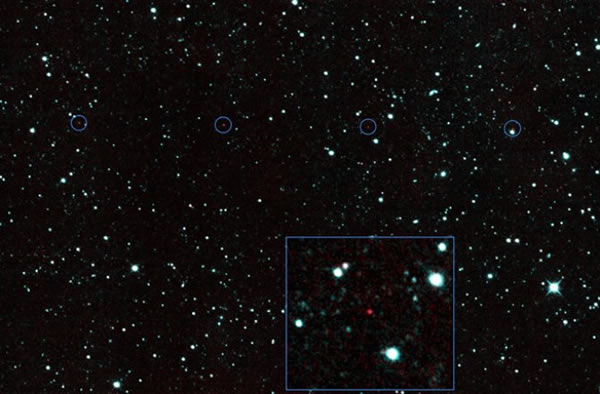Recommissioned NEOWISE Discovers Near-Earth Asteroid
Thar she goes: NEOWISE images of the newly-discovered near-Earth asteroid 2013 YP139.
Less than four months after getting switched back on — and only days after its “next light” images — NASA’s re-commissioned NEOWISE mission has made its first discovery: a never-before-seen near-Earth asteroid 27 million miles (43 million km) away.
Identified in a series of images captured on Dec. 29, 2013 YP139 is a coal-black asteroid about 650 meters — over 2,100 feet — wide. The image above shows the asteroid as a circled red dot as it moved across NEOWISE’s field of view over a period of several hours.
2013 YP139 would be all but invisible in optical light because it’s so dark, but it glows in infrared because it emits heat absorbed from the sun. NEOWISE — formerly just WISE — is an infrared space telescope that’s specially designed to pick up the faintest infrared emissions, making it perfect for spotting these hidden (and nearby) cosmic objects.
In its former life, WISE (Wide-field Infrared Survey Explorer) scanned the entire sky, helping astronomers discover the coldest stars, the universe’s most luminous galaxies, and some of the darkest near-Earth asteroids and comets. After running out of the coolant necessary to hide its sensors from its own heat, WISE began its NEOWISE campaign, discovering around 34,000 new asteroids (135 of which are NEOs). Then, in 2011, the spacecraft was put into hibernation. But in September of last year it was reactivated to help NASA identify potentially hazardous near-Earth objects (NEOs).
“We are delighted to get back to finding and characterizing asteroids and comets, especially those that come into Earth’s neighborhood,” said Amy Mainzer, the mission’s principal investigator from NASA’s Jet Propulsion Laboratory in Pasadena, Calif. “With our infrared sensors that detect heat, we can learn about their sizes and reflectiveness.”
While 2013 YP139 is classified as “potentially hazardous” and its orbit may bring it within 300,000 miles (490,000 km) of Earth, it won’t do so for at least another century. Still, thanks to NEOWISE, its path can be monitored to determine where it may end up in the more distant future.(Jan 7, 2014 06:19 PM ET // by Jason Major)












